OPTIONAL
Technical Training Field Trips
Wednesday, August 3, 2011
Please note the number of participants individual field
trips are limited to is published at the top of each flyer.
Field trip seating is very limited therefore
participation is restricted to meeting attendees only.
Sorry, no guests.
Click here
to print one PDF of ALL Field Trip flyers. Individuals flyers
may be accessed through the PDF links below.
|
Patapsco River Dam Removal
Projects � Bloede Dam, Simkins Dam and Union Dam
(Limited to 20 people)
Bus Departs Hotel at 11:30am
Returns to Hotel at 5:30pm
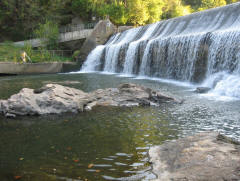 Bloede
Dam is 220 feet long, 40 feet wide at the base and
has a drop of 26.5 feet. It is an Amburson Hydraulic
Construction Company (Boston type) reinforced
concrete slab and buttress dam. It was the first
known instance of a submerged hydroelectric plant
where the power plant was housed under the spillway.
It is also recognized as one of the earliest dams
constructed of reinforced concrete. Bloede
Dam is 220 feet long, 40 feet wide at the base and
has a drop of 26.5 feet. It is an Amburson Hydraulic
Construction Company (Boston type) reinforced
concrete slab and buttress dam. It was the first
known instance of a submerged hydroelectric plant
where the power plant was housed under the spillway.
It is also recognized as one of the earliest dams
constructed of reinforced concrete.
Simkins and Union Dams will have been
removed. The former sites of these dams will be
visited. Union Dam was removed from October 2009 to
September 2010 using a heavily engineered approach
with multiple river diversions and realignment of
the stream channel. In contrast, the Simkins Dam
removal used a passive sediment management approach
releasing approximately 80,000-100,000 cubic yards
of sand and gravel that was stored behind the dam.
Intensive monitoring of the site has been conducted
with its removal and data will be shared at the site
visit.
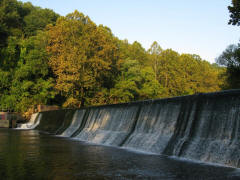
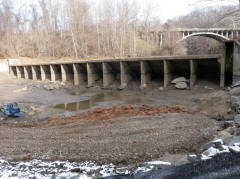
Detailed Tour
Information (Printable PDF) |
|
Urban Stream Restoration Site (Limited
to 20 people)
Bus Departs Hotel at 11:30am
Returns to Hotel at 7:30pm
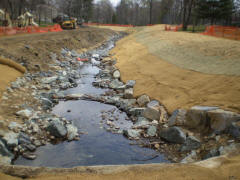 The
first stop at Spring Branch, an eroding headwater
stream system, will focus on a more than 10-yr old
restoration project which included the restoration
of a concrete trapezoidal channel. The
first stop at Spring Branch, an eroding headwater
stream system, will focus on a more than 10-yr old
restoration project which included the restoration
of a concrete trapezoidal channel.
The second stop will be at Mine Bank Run, a
restoration project which has been the focus of
years of research and monitoring. In addition to
describing the restoration, we will discuss the
results of the University of Maryland�s site
studies.
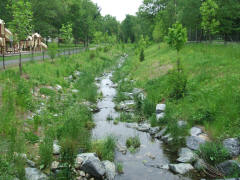 The
final stop will be Stony Branch, a more recent
approach to stream restoration involving the removal
of legacy sediments and restoration of the
relationship between the stream and its floodplain.
This project was controversial and occupied the
local new for weeks as a result of the removal of
the forested riparian cover to restore floodplain
connection. The
final stop will be Stony Branch, a more recent
approach to stream restoration involving the removal
of legacy sediments and restoration of the
relationship between the stream and its floodplain.
This project was controversial and occupied the
local new for weeks as a result of the removal of
the forested riparian cover to restore floodplain
connection.
Detailed Tour
Information (Printable PDF)
|
Tidal Wetland and Vernal Pool Restoration Site
(Tour is limited to 20 people)
Bus Departs Hotel at 11:30am
Returns to Hotel at 7:30pm
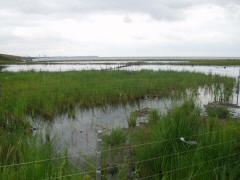 The
Cox Creek mitigation site is associated with the
Cox Creek Dredged Material Management Facility (DMMF).
The reconstruction of the Cox Creek DMMF resulted in
the need for mitigation. The 12-ac mitigation site
was an 8-ac mono-typic Phragmites stand and a
four-acre still pond (both above the influence of
tide). The mitigation project involved the
excavation and removal of the Phragmites, lowering
the site into the intertidal range. The
Cox Creek mitigation site is associated with the
Cox Creek Dredged Material Management Facility (DMMF).
The reconstruction of the Cox Creek DMMF resulted in
the need for mitigation. The 12-ac mitigation site
was an 8-ac mono-typic Phragmites stand and a
four-acre still pond (both above the influence of
tide). The mitigation project involved the
excavation and removal of the Phragmites, lowering
the site into the intertidal range.
The mitigation target was to create a mosaic of
unvegetated open water, vegetated marsh, and a beach
strand
 dominated
by supra-tidal shrub community. This was
accomplished through over-excavation of areas to
create sub-tidal ponds, grading of other areas to
intertidal marsh elevations for both Spartina
alternifora and Spartina patens communities, and
either retention of beach strand or building-up of
beach strand to an elevation above normal tidal
influence. A tidal channel connection was created,
and the site was planted. The presence of Canada
geese led to erection of exclusion fencing across
the site. dominated
by supra-tidal shrub community. This was
accomplished through over-excavation of areas to
create sub-tidal ponds, grading of other areas to
intertidal marsh elevations for both Spartina
alternifora and Spartina patens communities, and
either retention of beach strand or building-up of
beach strand to an elevation above normal tidal
influence. A tidal channel connection was created,
and the site was planted. The presence of Canada
geese led to erection of exclusion fencing across
the site.
Detailed Tour Information (Printable PDF) |
Smithsonian Environmental Research Center (SERC)
(Tour is limited to 20 people)
Bus Departs Hotel at 11:30am
Returns to Hotel at 6:00pm
 Participants
will be introduced to the research conducted at the
Smithsonian Environmental Research Center by meeting
with two research scientists and then will be
presented with a general overview of all the
research conducted at the 18 different laboratories
housed onsite. The first speaker, Dr. Pat Megonigal
works in the Biogeochemistry lab and will discuss
the impacts of global climate change on plants and
intertidal zones, relating specifically to CO2 and
sea level Participants
will be introduced to the research conducted at the
Smithsonian Environmental Research Center by meeting
with two research scientists and then will be
presented with a general overview of all the
research conducted at the 18 different laboratories
housed onsite. The first speaker, Dr. Pat Megonigal
works in the Biogeochemistry lab and will discuss
the impacts of global climate change on plants and
intertidal zones, relating specifically to CO2 and
sea level
 rise.
During this talk participants will be shuttled to
the world�s longest running CO2 study site to look
at the chambers used for this research. Next Dr.
John Parker will discuss the impacts of invasive
species on ecosystem landscapes, and herbivory by
large mammals. His research speaks directly to human
impacts on native ecosystems. The last talk of the
day will be an overview of the other 16 laboratories
at SERC and their global and local research.
Laboratories discussed will include the Fish and
Invertebrate Lab, Plant Ecology Lab, Plant and
Animal Interaction Lab (Mangroves), Nutrient Ecology
Lab, Marine Invasive Species Lab and more! rise.
During this talk participants will be shuttled to
the world�s longest running CO2 study site to look
at the chambers used for this research. Next Dr.
John Parker will discuss the impacts of invasive
species on ecosystem landscapes, and herbivory by
large mammals. His research speaks directly to human
impacts on native ecosystems. The last talk of the
day will be an overview of the other 16 laboratories
at SERC and their global and local research.
Laboratories discussed will include the Fish and
Invertebrate Lab, Plant Ecology Lab, Plant and
Animal Interaction Lab (Mangroves), Nutrient Ecology
Lab, Marine Invasive Species Lab and more!

Detailed Tour Information (Printable PDF) |
|